Philodendron Birkins are tropical beauties thanks to their deep green leaves and striking stripes. With their slow growth and upright habits, they’re not difficult plants — just watch out for overwatering!
The most important aspect of philodendron Birkin care is light. Your plant needs lots of bright, indirect light to keep that signature variegation. (Just not direct sun, which can burn the leaves.)
With proper care, your Birkin will reward you with large leaves that make a statement anywhere in your home! And with its easygoing nature, it’s the perfect starting point if you want to look after a variegated plant.
Soil or Potting Mix | Light | Pot Setup | Environment | Watering | Repotting | Pruning | Fertiliser | Propagation | Common Problems
Brush Up on the Birkin Plant
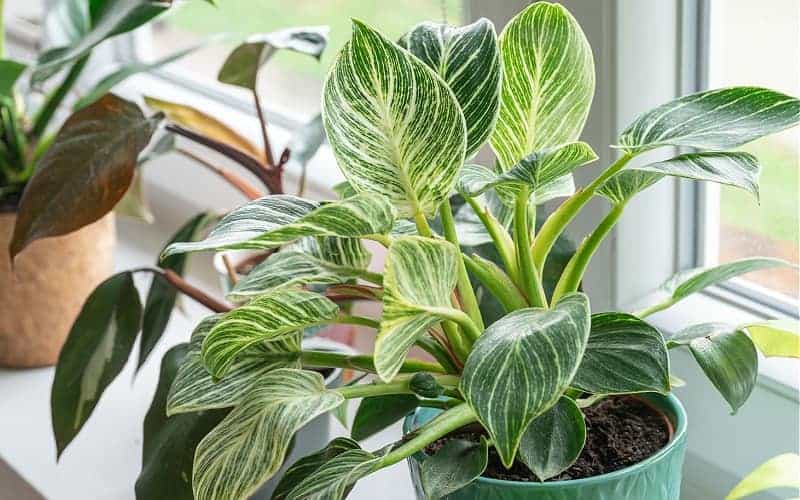
Most philodendrons are tropical plants native to South and Central America. In the case of the philodendron Birkin, though, it’s not actually found in the wild!
This plant is believed to be a spontaneous mutation of the philodendron ‘Rojo Congo’ — which, in turn, is a hybrid of the Philodendron tatei.
The Birkin is also known as philodendron ‘White Wave’ thanks to the white or yellow variegation pattern on the dark green leaves. The patterns only appear on mature plants, and may have slight pink or red accents.
However, the variegation is unstable, meaning the foliage can revert to solid colours. Other times, your Birkin might produce an all-white or cream leaf.
Since the philodendron Birkin is a compact plant, it’s perfect for shelves, desks, and other indoor settings. Just make sure it gets plenty of indirect sunlight!
Philodendron Birkin Growing Conditions
Philodendrons are pretty low-maintenance, whether you keep them indoors or out in the garden.
Like other variegated plants (such as the Pink Princess), the key factor is light. That, alongside proper drainage and a mild environment, will keep your philodendron happy.
Soil or potting mix
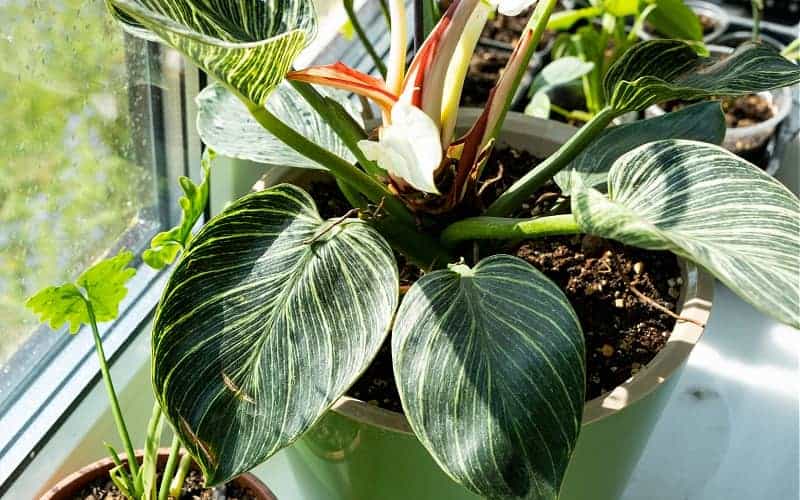
When looking for philodendron Birkin soil, choose a well-draining, soilless potting mix that’s slightly acidic. A chunky aroid mix works well!
Alternatively, add perlite, coir, and bark to regular indoor potting soil.
The ideal mix should retain moisture but drain freely, so your plant doesn’t become waterlogged.
Lighting
A philodendron Birkin’s light requirements are key to maintaining its stunning foliage.
Place your Birkin plant somewhere that gets bright, indirect light for at least 6 hours a day. For indoor plants, consider an east or northeast-facing window in Australia.
Keep the philodendron out of direct sunlight, especially during afternoons. Too-strong light can scorch the variegated leaves.
However, too little light and your Birkin can revert to plain green leaves! Make sure that you can see the sky outside from your plant’s position — otherwise, it won’t get enough sun.
Don’t have a good window? You can keep your philodendron under a full-spectrum grow light for 8–10 hours a day.
Pot and support

Choose a good container with plenty of drainage holes, like a nursery pot. Avoid terracotta since it can make the soil dry out too quickly.
When choosing a philodendron Birkin pot size, go for 2–6cm larger than the root ball. A too-big pot means more soil and moisture, which can lead to waterlogging.
Since Birkins are self-supporting plants with thick stems, consider giving them a stake or support pole! That helps keep them upright, especially if they become too bushy or top-heavy.
Plant environment
Philodendron Birkins thrive in warm and humid spaces, since these plants have tropical origins.
Ideal temperatures would be between 18º–30ºC, with humidity levels between 40–70%. Keep Birkin plants out of cold drafts or strong winds.
Avoid exposing your philodendron to conditions lower than 13ºC. For outdoor plants, bring them indoors during winter or rainy periods.
How to Take Care of a Philodendron Birkin
Once you’ve got your Birkin set up in a cosy spot, it needs proper care to keep it healthy and thriving.
It’s not a very fussy plant, so if you neglect it a bit, it’ll be fine.
When to water a philodendron Birkin
Birkin plants tolerate a lack of moisture better than overwatering! However, you shouldn’t let your plant dry out too long or the foliage will wilt.
There’s no need for a strict watering schedule. Instead, give the plant a drink when the potting mix is 75% to almost fully dry.
You can also go by “feel” — if the pot is very light when picked up, the soil is mostly dry.
How often you water a philodendron Birkin will depend on things like sunlight, temperatures, and pot size. For example, the pot will dry out slower in cool weather, so you may end up watering less often.
For most Birkins (and indoor plants), you’ll likely have to water every 1–2 weeks.
When and how to repot a philodendron Birkin
Compared to other philodendrons, the Birkin is slow-growing, so it shouldn’t need a new container too often.
Repot your philodendron Birkin when you notice signs such as:
- Circling or crowded roots
- Slowed or stunted growth
- Roots poking out of drainage holes
- Soil drying out quickly or more frequently
When repotting, opt for a pot that’s around 2–6cm (1–2in) larger than the current container. If the new pot is too big, you risk suffocating the plant’s roots.
Carefully wiggle or push the Birkin out of its container. Inspect the soil to make sure it’s in good condition (e.g. not hydrophobic) — if yes, no need to remove it.
Place the roots and soil together in the new pot and fill in the gaps with fresh potting mix. Shimmy the pot a bit to settle the plant, then water thoroughly.
Does a philodendron Birkin need pruning?
Birkin plants are slow growers, so there’s no need to prune unless the plant has dead or damaged leaves.
Leave yellow, ageing leaves alone unless you feel they’re a sign of other issues such as over-watering or pests.
For large plants, you can prune leaves or stems to create a more compact appearance. Always use disinfected shears and cut close to the stem or between leaf nodes.
Do philodendron Birkins need fertiliser?
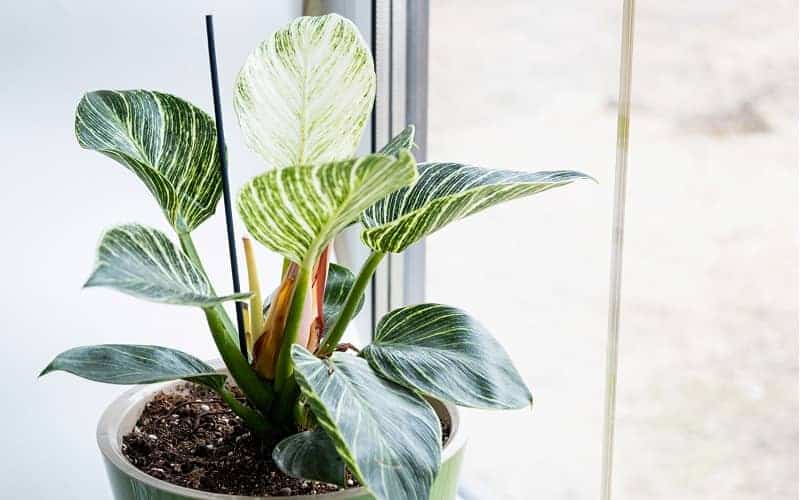
Indoor houseplants don’t always need fertiliser, but it can help plants with soilless potting mixes! Fertiliser will restore nutrients and encourage faster, more lush growth.
Give your philodendron Birkin a weak solution of balanced fertiliser every 4–6 weeks during the growing season (spring and summer).
During cooler or rainy seasons, scale back to every 10–12 weeks — or skip it entirely.
Philodendron Birkin Propagation
If you can’t get enough of your philodendron Birkin, you can propagate it!
You can take cuttings from your Birkin anytime, but try to do so in spring when the parent plant sees healthy and robust growth.
Using a pair of disinfected shears, cut an 8–10cm (3–4in) section of stem, preferably from the tip. Make sure the cutting has at least one node and a few aerial roots.
Remove any leaves from the bottom half of the stem, then place the cutting in a clear bottle or jar. Add enough water to cover the nodes.
Keep the container in indirect light or under a grow light. You should start to see new roots after 4–6 weeks.
BTW — you don’t need to change the water unless it becomes dirty or murky, or you see algae growth! Just top it off if the level gets low.
Once secondary roots come in, you can transfer the cuttings. Plant them in a small pot (10cm or less) with your chunky potting medium and keep the soil consistently moist as the roots adjust.
Common Problems with Philodendron Birkin
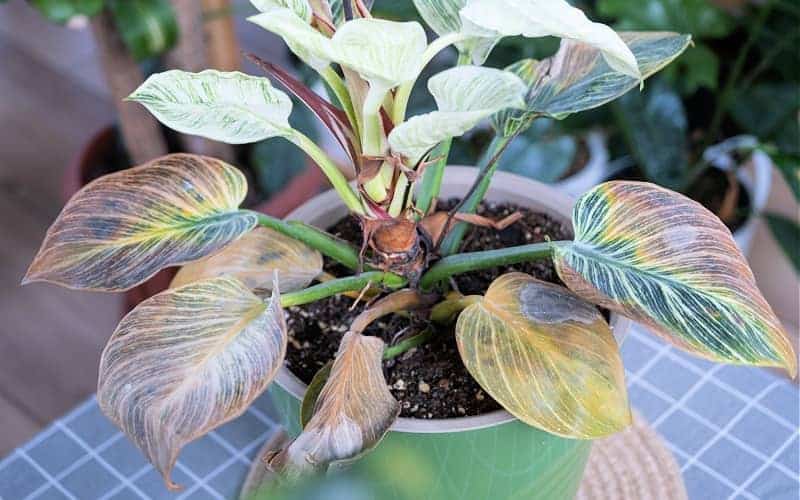
The Birkin plant is pretty sturdy, but things like insufficient light or improper care can cause some issues.
You may also get some pests, even indoors.
Does a philodendron Birkin revert?
Like other variegated philodendron cultivars, the Birkin can revert to all-green leaves in low-light conditions. Keep your plant where it gets plenty of indirect light or under a full-spectrum grow light.
However, the leaves may revert regardless of lighting since the Birkin has an unstable variegation. That means new growth may have little to no stripes.
(Fun fact — many plant owners have nicknamed them the “Reverkin” because of this.)
Why are philodendron Birkin leaves turning yellow?
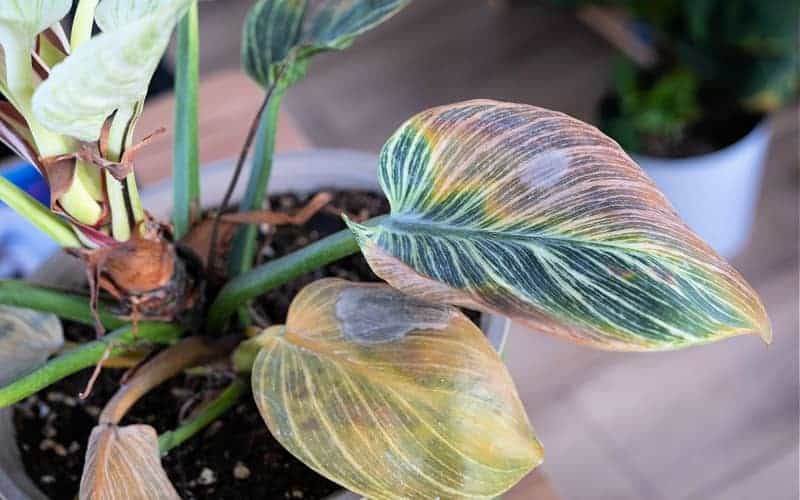
If you notice several yellow, drooping leaves, your philodendron Birkin may have root rot.
Overwatering (watering too often) is the most common cause of root rot. Other issues include poor drainage, too-large pots, or too-cold temperatures — all of which lead to excess moisture in the potting mix.
Besides wilted yellow leaves, symptoms of root rot include stunted growth and soggy soil.
Identify root rot by removing the plant and checking for black, mushy, or smelly roots. If yes, you’ll need to repot your Birkin immediately.
Rinse off all the soil and cut off the affected roots with disinfected pruning shears. Plant the Birkin in fresh soil, then wait a few days before watering.
However, a few yellow leaves near the bottom are just old! This is a natural part of the life cycle and the leaves will fall off naturally.
Why are my Birkin plant’s leaves brown?
Brown leaves mean your Birkin is too dry or is getting too much sun.
If the foliage is brown and crispy, the Birkin philodendron needs water or higher humidity levels. Water the soil, and consider increasing humidity by plant grouping or a small humidifier.
Avoid misting or pebble trays, though — these don’t actually help!
Leaves that have brown tips and curled edges are a sign of too much sun. Variegated leaves are susceptible to scorching, so you need to keep them out of direct sunlight.
Move the plant away from a window or, for outdoor plants, in a partially shaded area out of the afternoon sun.
Are there philodendron Birkin pests?
A healthy plant is resilient, but Birkins can still suffer pest infestations.
Spider mites are some of the worst pests for indoor plants. The small, reddish-brown pests feed on leaves and suck out nutrients.
Other common pests on household plants include fungus gnats, mealybugs, and thrips.
To treat pests on your philodendron Birkin, remove the bugs with a damp cloth or spray the foliage with water and insecticidal soap. Then prune off affected leaves or stems.
Check nearby plants for infestations as well!
FAQs about the Philodendron Birkin Plant
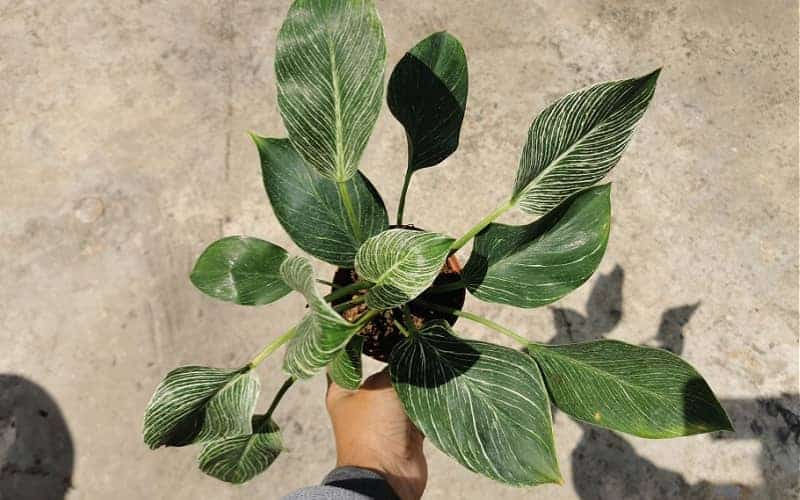
Let’s round up a few more questions that people have about philodendron Birkin care.
Is philodendron Birkin a good indoor plant?
Birkin plants are excellent for indoor settings, as long as they get plenty of light and adequate humidity.
It’s easier to control the growing conditions indoors, so you can position your plant anywhere so long as it has the right environment.
Does a philodendron Birkin climb or trail?
Neither, actually — Birkin plants have upright, self-supporting stems, so they stand on their own.
That sets them apart from other varieties like the popular heart-leaf philodendron, which has long vining stems that can trail or climb.
Do Birkins like to be root-bound?
Philodendron Birkins can tolerate being slightly rootbound, but it can hurt the plant eventually.
Being rootbound means there’s not enough soil or space for the roots. This can lead to stunted growth and wilted leaves.
Are Birkin philodendrons toxic?
Yes! Like other philodendrons, the Birkin is toxic to cats, dogs, and other animals.
All parts of the plant contain calcium oxalate crystals, which cause swelling, drooling, and vomiting if ingested.
If your pet may have licked or chewed your plant, bring it to a vet ASAP.

